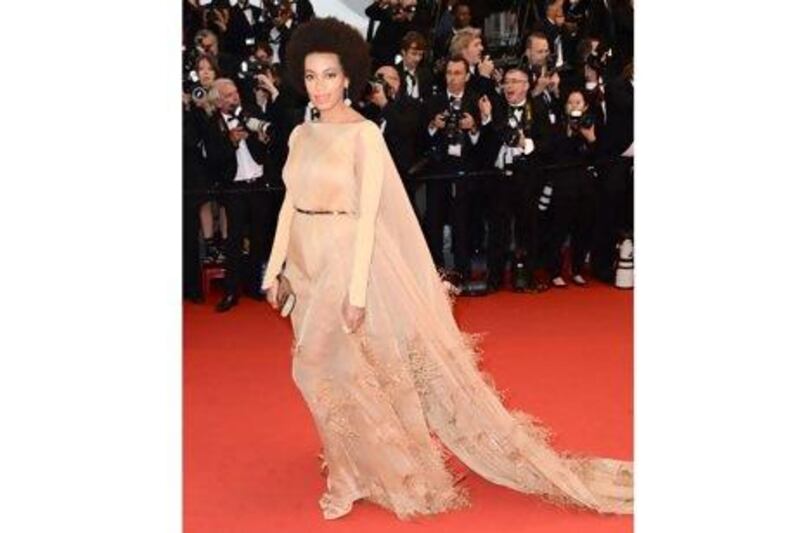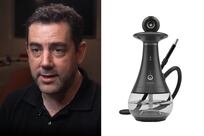We speak to the French designer Stéphane Rolland who is in Abu Dhabi to open his flagship store.
Tell me about the concept behind your marble-accented boutique in Etihad Towers.
I wanted to create something very different to what we’re used to seeing and make the boutique a little bit like an apartment. It has many architectural touches and is very 1970s-inspired, because I think it was one of the most creative and innovative times for art and fashion. I wanted every single detail to be super-luxurious, right down to the service, but people will still feel at home. The mood and energy of the boutique is also good and the warm light is important because it flatters the body, the face and the clothes.
Why Abu Dhabi?
Mainly because the Middle East means a lot to me and Abu Dhabi is up-and-coming. I was adopted by the people a long time ago so it was a chance to give something back. When I was in my teens, I read about Sheikh Zayed. He was one of the leaders I admired because he did so much for the country and I’ve always been fascinated by the culture and history of the region.
It sounds like the region is something of a spiritual home for you.
Exactly. I love Paris, but I’m sure I’ll finish my days in a tent in the desert. What’s difficult for me is not being able to live that now. I need it, deeply. I work a lot and travel a lot and I really feel like a Bedouin. I’ve never owned an apartment and I don’t have an appetite for material things.
How did the Iraqi-British architect Zaha Hadid come to influence you?
When I discovered her a long time ago, I recognised myself in her work. It was so organic and feminine, with some of the curves of her buildings just like the curves of a woman’s body. There’s a generosity to her design. I also find that with [the Anglo-Indian sculptor] Anish Kapoor’s work – structurally I clearly like things to be big.
Making headlines in your couture at the Cannes Film Festival this week was Solange Knowles – what did you make of the styling?
Yeah! She made a buzz with that dress [laughs]. I loved the pictures and the wind making her dress flow. She has the legs and body to wear it and looked so 70s with the Afro hair – I loved it! She was refreshingly different from what we normally see on the red carpet.
Spanish actress Paz Vega also wore one of your gowns in Cannes. How does dressing a star work in practice? Do they come to Paris for fittings with you in the months prior?
Sometimes, but not normally. Maybe Paz or Kim [Kardashian] will, but with someone like Beyonce, I send the dresses to her as I’m travelling all the time and so is she.
Are the gowns always gifted or are they occasionally paid for?
No, they’re not to be honest – but a few, yes – because they are special orders or requests for a certain design etc. The ladies need so many dresses all year long, they cannot pay, I do understand that.
Let’s go back to when it all began for you, at the age of 19 and working as an intern for Balenciaga in Paris. Within a year you were appointed creative director of menswear – how did you cope with the pressure at that age?
I wasn’t conscious of it because I was living my dream. I was working a lot and never home before midnight but I was happy for the first time in my life. I did my first fashion sketch at 4 years old and when I eventually got to Paris after my exams at 17, I started to breathe. I thanked God I had arrived and couldn’t wait to get started on my career. Attending fashion school, I looked around and finally I fitted in, I was surrounded by like-minded people. Balenciaga saw my sketch book when I was an intern with them and thought it was the essence of the brand. Yes, I had limited experience, but they asked me to join the team and I signed the contract less than a year later.
You left Balenciaga to set up on your own at 24 – what caused the split from the maison?
The problem I have sometimes is being too frank. It was quite difficult for me to deal with the management there and I questioned what they were doing with the brand. For me, if there’s one standout name in fashion, it is Cristóbal Balenciaga – not the brand, the man himself. And when I see businessmen buying brands and doing awful things to them, it’s very sad. So I opened my company and I had no money. I signed a contract with Balmain for producing luxurious uniforms and became a leader in the European field. It was a great way to raise money to create my own brand. Then [the designer] Jean-Louis Scherrer asked me to become couturier of his brand and as it was a great global opportunity, I couldn’t refuse. The collaboration lasted more than 10 years.
You were the youngest haute couturier Paris knew at that time, was that a professional pinnacle for you?
Hmm, I’m not sure, it was certainly an experience! I think you can express yourself in so many different ways [as well as couture]. Yes, I’m a fashion designer but I love to design furniture and jewellery too – everything is about design for me. Haute couture for me – is interesting because it set limits which make you more creative and I do like a challenge.
Do you ever pay heed to critics in the press?
It depends who criticises.
Whose opinion in the fashion-media sphere matters most?
Mine. [laughs] At the end of the day, what can you do with the critics? If they don’t like it, they don’t like it. If they like it, good, thank God. It’s difficult not to take criticism personally and I don’t like it when bad things are said about the stars. There are good and bad journalists. Of course, anyone can make mistakes, as a designer or even as a star wearing a certain dress – but there’s really no need to be so aggressive.
Follow us
[ @LifeNationalUAE ]
And follow us on Facebook for discussions, entertainment, reviews, wellness and news.





